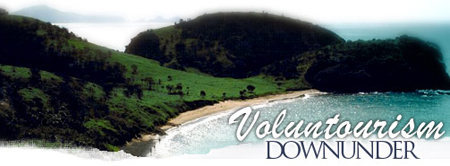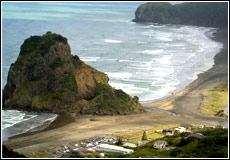|

The
Wild, Wild West Coast of New Zealand
by
Christine Brooks
As
a part of RTM's International Issue,
we're delving into the world of voluntourism.
Here, one of our readers shares her
inspirational work exchange journey
to New Zealand…
 I
arrived in New Zealand at the peak
of its summer on Feb. 4, and was immediately
greeted by Peter, owner and operater
of the Piha Surf Shuttle. His smile
and thick New Zealand accent instantly
told me I was home, though this South
Pacific community was far from the
place I was born and raised. I
arrived in New Zealand at the peak
of its summer on Feb. 4, and was immediately
greeted by Peter, owner and operater
of the Piha Surf Shuttle. His smile
and thick New Zealand accent instantly
told me I was home, though this South
Pacific community was far from the
place I was born and raised.
After a 45-minute ride, Peter and
I entered New Zealand's protected
rainforest, which left me speechless.
All around us were thick, rich trees,
plush grasses and vines. Peter rolled
down the window so I could smell the
magnificent native tea tree, which
grew wildly among the forest. It was
a little surprising to learn that
New Zealand doesn't have many native
animals, and that I wouldn't be seeing
koala bears or monkeys swinging from
any of the branches as I expected.
Alas, there were not any alligators
or crocodiles either.
The road to Piha, our destination,
was extremely curvy, offering little
room on either side for driver error.
I saw no view of street signs either.
When I asked Peter about this he assured
me that he knew just where he was
going. "No worries," he
said. At the top of Seaview Road,
Peter pulled over for a moment so
I could see the ever-famous Lion Rock
and Piha Beach in all its glory. It
was paradise. A few more minutes on
the road and we pulled into Piha Surf,
where owners Pam and Mike Jolly greeted
me with tea and coffee. After a few
minutes of socializing, Peter was
off again to shuttle even more people
to one of the most famous surf beaches
around.
Piha
Surf - the campground at which
I would be providing labor in return
for lodging - was a bustling place.
After a brief tour of the campground,
I was left on my own. Within seconds,
I dropped off my bags and headed down
to the beach and its nearby town.
After an incredibly steep and windy
walk down the mountain, I headed into
what I thought was the center of town
to have a look around. It was then
that I learned there wasn't actually
a town center. It was more of a village,
consisting of the Piha Store, the
post office (open an incredible eight
hours per week), a nonprofit art gallery
and the Piha Volunteer Fire Department.
After checking out the store and its
small surf
shop, I made my way down to
the beach.
Before hitting the black sand I stopped
to take in the various warning signs
posted nearly everywhere! "Strong
rip currents," "unstable
cliffs" and "dangerous swimming"
warnings were posted at every beach
entrance. Two orange and red flags
were positioned on the beach and swimmers
were instructed to only swim betwen
the markers to make any water rescues
easier. My first day saw more than
20 swimmer rescues. However, I was
tired and jetlagged, so that day I
only dip my toes in. Swimming and
surfing could wait.
After a much needed rest, I began
my work with Willing Workers on Organic
Farms (WOOF). WWOOF is an organization
that allows people to travel all over
the world and work in exchange for
room and board. My work took place
at Piha Surf, and was actually more
fun than expected. I worked for three
hours each day, doing everything from
picking up sheep poo, to painting
an A-frame, to repotting a plant.
After that, my time was my own to
relax, hike, surf, swim or just explore.
A few minutes down the road from Piha
Surf I found an awesome waterfall
known as Kite Kite Falls. It was truly
an amazing sight, resting just a few
minutes off the main road. My hike
wound through a nearby rainforest,
where the sights and sounds of the
forest entertained me while the trees
provided much needed shade for my
first trip to Kite Kite. Each day
in Piha, though similar to the day
before, was never boring. It seemed
that every trip to the beach or forest
provided something different. So much
so that I knew it would be impossible
to soak in all that Piha had to offer
during my short stay there. The weekends
in Piha did offer change from the
weekdays though. People would pour
in from nearby Auckland and crowd
the beaches, surf shop and the beach's
only restaurant, Blair's. These weekend
warriors provided entertainment though,
as people-watching was at its peak.
The three eateries in the nearby town
also brought nightlife to Piha. However,
restaurants were more of gathering
places with the nightlife consisting
of surfers gathered to talk about
the waves. The three restaurants,
the Surf Club, the Bowling Club and
the RSA Club, were more than happy
to serve up Speicht's beer and steak
burgers while locals gathered to compare
stories. On my last night there, the
lifeguards joined us but had to leave
abruptly when a local woman went missing.
Apparently this was nothing out of
the ordinary.
As the guards charged toward the water,
quickly changing as they made their
way to the "rubber duckie"
rescue boat, they were all business.
It was obvious that they were true
professionals and they too respected
the power of Piha Beach's water. Mother
Nature was no joke in this neck of
the woods. Luckily, after an extensive
search by boat, scuba and helicopter,
the missing woman was found...in her
kitchen. I guess this too was typical,
as no one seemed a bit surprised.
The surf in Piha was challenging,
as the waves were deceivingly large
and extremely powerful. Surfers weren't
required to stay within the beach's
warning flags, but the flags did serve
as important guideposts. I quickly
found this out as the water constantly
pulled me away from the flags towards
the rocks. The first few waves sent
me flying, causing even my surf instructor
Jon Paul to laugh as I struggled to
paddle out into the water. It's funny
how calm the water always looks from
the beach! After a few hours though,
I got the hang of things and even
managed to face the waves head on
without screaming. Later I found out
the waves I had been riding all day
were small by local standards.
As the days turned into weeks, I knew
my wonderful trip was nearing its
end. Although I looked forward to
the comfort of indoor plumbing, there
were so many things about Piha I would
miss, like the midday tea and chocolate
covered biscuits. I would miss the
Tui birds that got drunk off flower
pollen, wobbling around while they
sang, hanging themselves upside down
by one leg from the tree outside my
window. I would miss the sound of
the ocean as I drifted off to sleep.
Most of all though, I would miss the
people.
I would miss how truly carefree the
locals were, and just how wonderful
they made me feel. There was something
about the rugged New Zealand coastline
and its gracious villagers that welcomed
me and made me feel at home.
If you are lucky enough to get to
New Zealand's west coast, stop in
and see Piha. It will be time well
spent. If you do make it all the way
to Piha, I hope you take the time
to visit the nonprofit art gallery
and have a coffee at the Piha Store.
Take the time to visit and get to
know these people, I promise they
are well worth the trip.
If
You Go…
For information on voluntourism, or
exchange travel,
visit WWOOF
USA. |